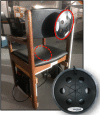How Neurophysiological Measures Can be Used to Enhance the Evaluation of Remote Tower Solutions
- PMID: 31551735
- PMCID: PMC6743038
- DOI: 10.3389/fnhum.2019.00303
How Neurophysiological Measures Can be Used to Enhance the Evaluation of Remote Tower Solutions
Abstract
New solutions in operational environments are often, among objective measurements, evaluated by using subjective assessment and judgment from experts. Anyhow, it has been demonstrated that subjective measures suffer from poor resolution due to a high intra and inter-operator variability. Also, performance measures, if available, could provide just partial information, since an operator could achieve the same performance but experiencing a different workload. In this study, we aimed to demonstrate: (i) the higher resolution of neurophysiological measures in comparison to subjective ones; and (ii) how the simultaneous employment of neurophysiological measures and behavioral ones could allow a holistic assessment of operational tools. In this regard, we tested the effectiveness of an electroencephalography (EEG)-based neurophysiological index (WEEG index) in comparing two different solutions (i.e., Normal and Augmented) in terms of experienced workload. In this regard, 16 professional air traffic controllers (ATCOs) have been asked to perform two operational scenarios. Galvanic Skin Response (GSR) has also been recorded to evaluate the level of arousal (i.e., operator involvement) during the two scenarios execution. NASA-TLX questionnaire has been used to evaluate the perceived workload, and an expert was asked to assess performance achieved by the ATCOs. Finally, reaction times on specific operational events relevant for the assessment of the two solutions, have also been collected. Results highlighted that the Augmented solution induced a local increase in subjects performance (Reaction times). At the same time, this solution induced an increase in the workload experienced by the participants (WEEG). Anyhow, this increase is still acceptable, since it did not negatively impact the performance and has to be intended only as a consequence of the higher engagement of the ATCOs. This behavioral effect is totally in line with physiological results obtained in terms of arousal (GSR), that increased during the scenario with augmentation. Subjective measures (NASA-TLX) did not highlight any significant variation in perceived workload. These results suggest that neurophysiological measure provide additional information than behavioral and subjective ones, even at a level of few seconds, and its employment during the pre-operational activities (e.g., design process) could allow a more holistic and accurate evaluation of new solutions.
Keywords: ECG; EEG; GSR; asSWLDA; eye blink; machine learning; mental workload; remote tower air traffic management.
Figures














References
-
- Aricò P., Borghini G., Di Flumeri G., Colosimo A., Bonelli S., Golfetti A., et al. . (2016a). Adaptive automation triggered by EEG-based mental workload index: a passive brain-computer interface application in realistic air traffic control environment. Front. Hum. Neurosci. 10:539. 10.3389/fnhum.2016.00539 - DOI - PMC - PubMed
-
- Aricò P., Borghini G., Di Flumeri G., Colosimo A., Pozzi S., Babiloni F. (2016b). A passive brain-computer interface application for the mental workload assessment on professional air traffic controllers during realistic air traffic control tasks. Prog. Brain Res. 228, 295–328. 10.1016/bs.pbr.2016.04.021 - DOI - PubMed
LinkOut - more resources
Full Text Sources

